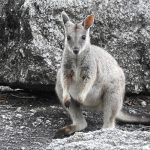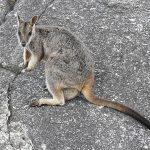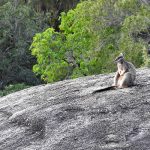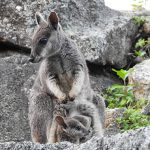MAREEBA ROCK-WALLABY
The Mareeba rock-wallaby is a medium-sized wallaby, with a body that measures around 50 to 60 centimetres in length, topped with a long, bushy tail that can reach up to 70 centimetres. Its fur is a soft, mottled grey-brown, perfectly suited to blend in with the rocky outcrops it calls home. A distinguishing feature is the pale stripe that runs down its cheeks, giving it a somewhat masked appearance.
These wallabies are endemic to the rocky escarpments and outcrops of the Atherton Tablelands near Mareeba, Queensland. They are skilled climbers, navigating the rugged terrain with ease, and may be seen hopping gracefully from rock to rock. Their strong hind legs and long tails are perfectly adapted for balance and agility, allowing them to navigate steep and rocky terrains with remarkable skill.
Mareeba rock-wallabies are herbivores, primarily feeding on grasses and leaves. Their diet can also include fruits and flowers, depending on the availability of these resources in their environment. Their ability to survive on relatively low-nutrient vegetation is a testament to their adaptability.
Breeding can occur throughout the year, but there tends to be a peak in births during the wetter months when food is more abundant. After a short gestation period of around 30 days, the female gives birth to a single joey. The tiny newborn then makes its way into the mother’s pouch, where it continues to develop for several months before venturing out.
While generally quiet, Mareeba rock-wallabies can produce a range of sounds, including clicks and hisses, particularly when alarmed or communicating with each other. These vocalisations, though subtle, play an essential role in their social interactions.
In the wild, Mareeba rock-wallabies can live up to 12 years, although this can vary based on environmental conditions and predation pressures.
Although rare, and listed as a near-threatened species under IUCN classification the Mareeba rock-wallaby is classed as one of “Least concern” under Queenland’s Nature Conservation Act 1992. Like many native species, it faces challenges from habitat destruction, competition with introduced species, and climate change.
These wallabies are often found in small groups, which provide safety in numbers and social interaction.
The Mareeba rock-wallaby holds cultural importance for Indigenous communities in the region, who have long respected and revered these animals.



















